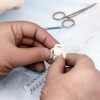Corneal infections
During a presentation on corneal infections, Sonal Tuli, MD, Gainesville, Florida, shared some of the differences between gram-positive and gram-negative bacterial keratitis.
Gram negative is characterized by developing explosively, copious discharge, frequent hypopyon, significant tissue destruction, ill-defined edges, and may have a ring.
Meanwhile, gram positive is characterized as developing insidiously, minimal discharge, mild A/C reaction, minimal tissue destruction, well-defined edges well, and may have an abscess.
To manage bacterial keratitis, Dr. Tuli said it’s important to rule out underlying causes, doing a culture, using empirical broad-spectrum antibiotics, and modifying based on the culture results.
She said to culture any large ulcer, and if the patient is already on antibiotics when he or she presents, it’s still beneficial to culture, but the yield decreases to around 50% of naïve ulcers.
Dr. Tuli added that the majority of cornea specialists in the U.S. treat with fortified antibiotics. She usually starts these patients on fortified antibiotics and will modify based on the gram stain and culture. Steroids can be used within 48 hours if there is an accurate diagnosis and antibiotics, she said.
Dr. Tuli also discussed the SCUT study, which found that there was overall no benefit or harm using steroids in bacterial keratitis. The study found that larger, central ulcers with worse vision did benefit.
Editors’ note: Dr. Tuli has no relevant financial interests.
Ocular surface neoplasia
Jennifer Li, MD, Sacramento, California, discussed ocular surface neoplasia in a detailed presentation.
One of the things she highlighted were risk factors for ocular surface squamous neoplasia (OSSN). These include fair skin complexion (Caucasian), male (5:1 ratio compared to females), cigarette smoking, chemical exposure, exposure to UVB, living within a 30-degree latitude of the equator, xeroderma pigmentosa, immunosuppression, and HPV 16 or 18.
Management options for OSSN may include superficial excision, adjunct cryotherapy, and topical chemotherapy.
For surgical excisions, Dr. Li said to do excision with a wide margin (2 mm), use rose bengal or lissamine green, and use a “no-touch technique.” With adjunct cryotherapy, she said that recurrence decreases from 30–50% to 8%.
Editors’ note: Dr. Li has no relevant financial interests.
DMEK complications
Mike Straiko, MD, Portland, Oregon, addressed DMEK complications, first noting several hurdles that can occur in DMEK, including graft ejection, intraoperative bleeding, intraoperative fibrin, primary graft failure, graft detachment, and pupillary block.
He said that pupillary block may be the most serious hurdle to get over because it can cause severe damage to the eye, so you have to make sure you have an open PI. To prevent pupillary block, Dr. Straiko recommended having an inferior PI.
Intraoperative bleeding, he said, may come from the angle or from the PI (especially when the IOP is lowered). To prepare for this, Dr. Straiko said to create the PI early in the case, tamponade any bleeding with Healon, and keep the IOP normal to high.
Meanwhile, fibrin may come from the angle or PI as well (especially when the IOP is lowered). Possible solutions are the same as with intraoperative bleeding and also to use I/A prior to graft injection.
Editors’ note: Dr. Straiko has no relevant financial interests.












